I sold my last film SLR in the late 1990s before my flirtation with digital, which quite quickly lost its appeal and I drifted back to film, continuing with digital mainly as a practical necessity in this modern age. That last film SLR was a Nikon F601 and one of the best cameras I had used up to that time. A few years ago I found a Nikon F801 in a local auction, a model reputed to have been one of the best pro quality models below the later top of the line F90/F100/F4 and so on. Now going from an F601 to an F801 may seem like a step up but is in fact a step backwards. The F601 came later in the time line and incorporated many features from the F801 plus a few improvements of its own. Nikon’s model numbering was somewhat confusing at the time, so bringing the prosumer range back in line with the, still not in date sequence, 301/401/501 numbering probably made sense from a marketing point of view.
Walk around
The Nikon F801 (otherwise also know as the N8008) camera is typically Nikon, finished in black with the distinctive red line alongside the handgrip.
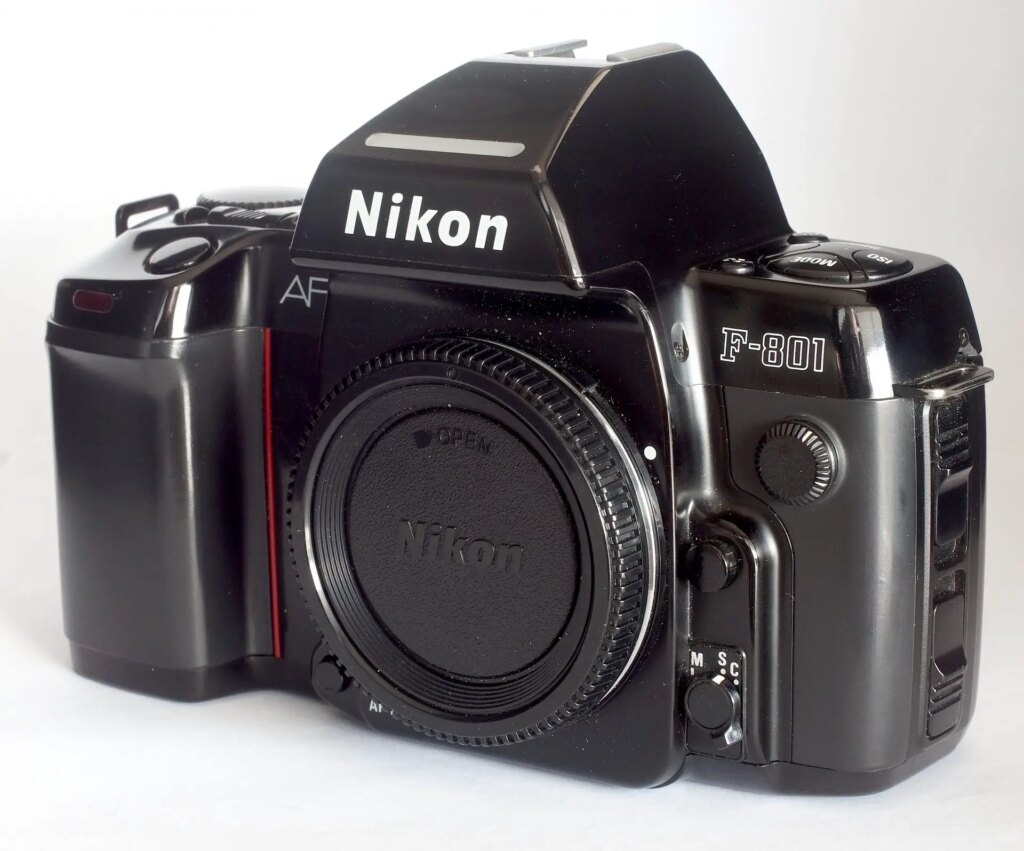
In the hand the Nikon F801 feels very much the business with a really solid, comfortable grip and the high eye-point finder from Nikon’s F3HP making it great to use. Nikon’s ergonomics and control approach has remained very consistent over the years, developing rather than innovating, so picking up most of their cameras from the 1970s onward can feel quite familiar.
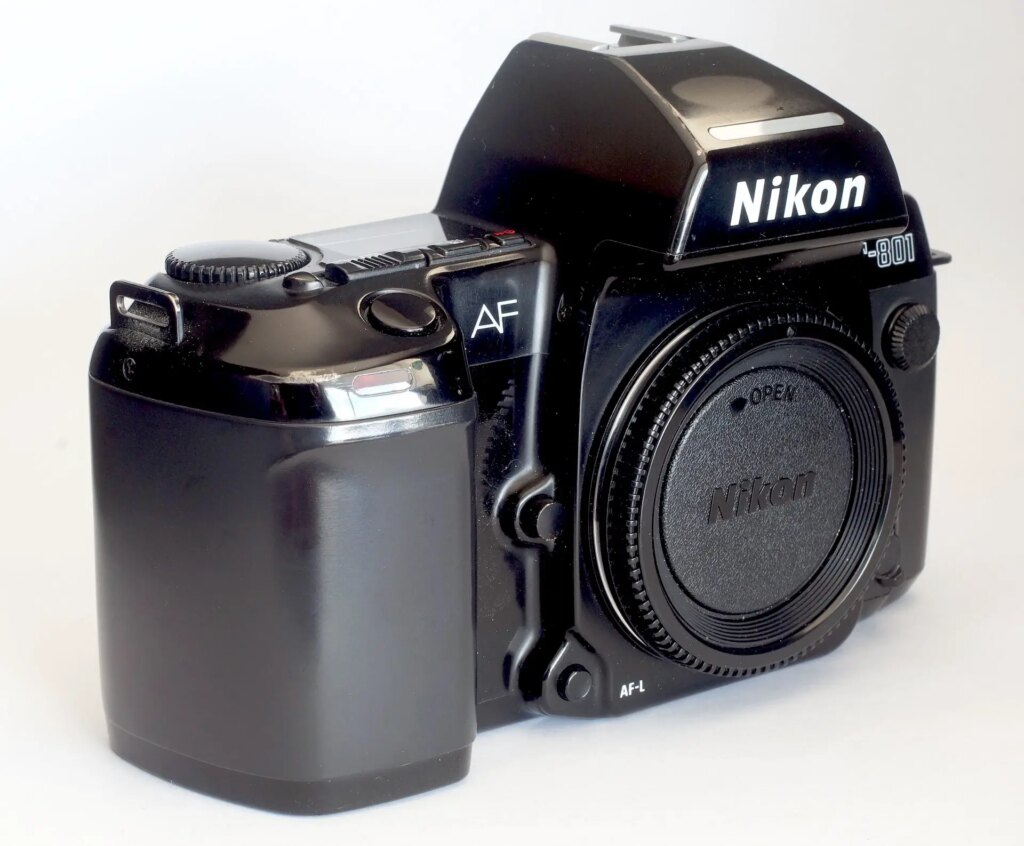
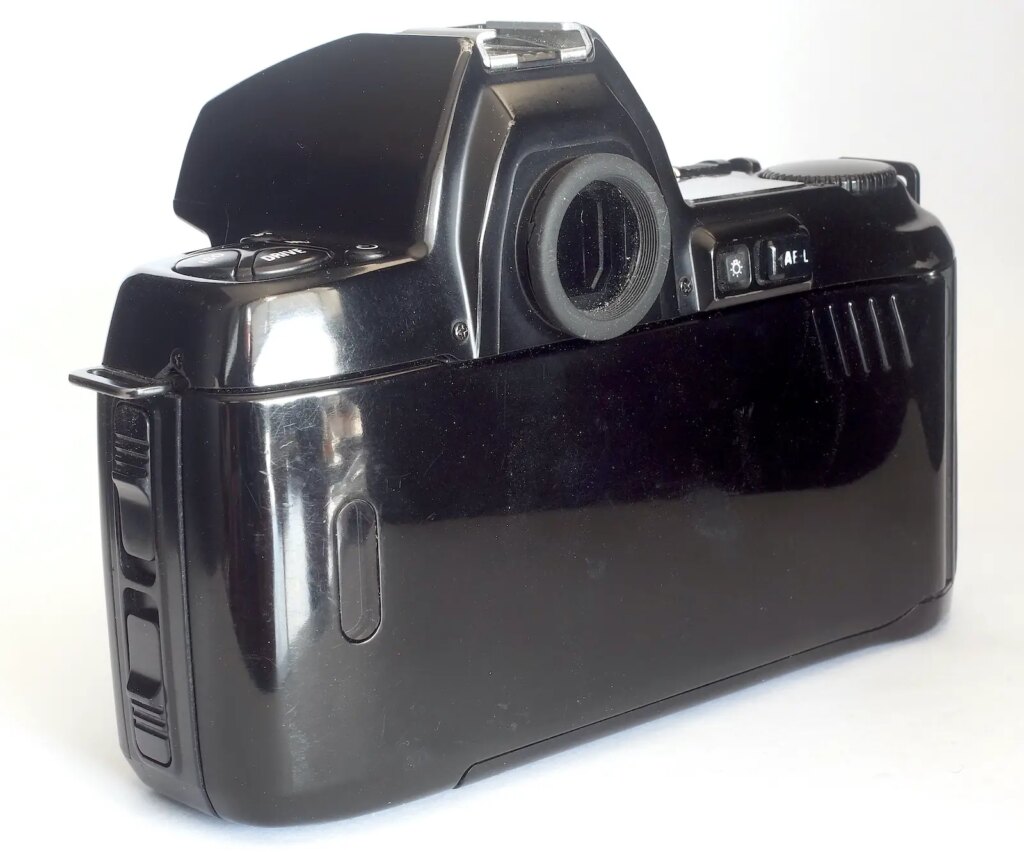
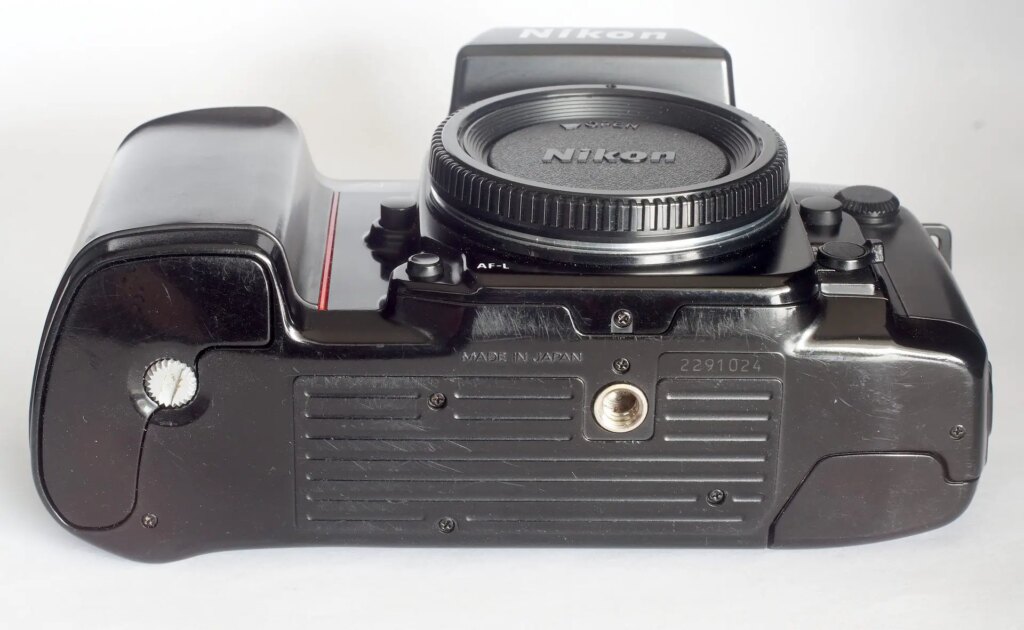
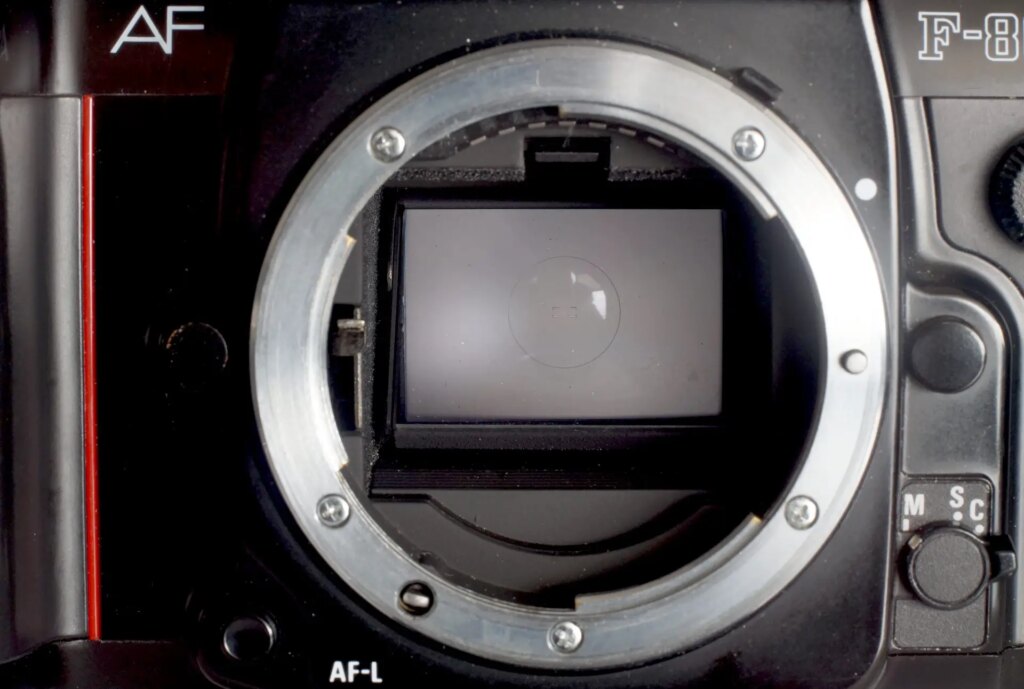
The big change here though was that the F801 was Nikon’s first camera to move to electronic, push button controls from the traditional wheels, one of the pioneers of the all electronic controls so commonplace now. Only one wheel is provided here which falls conveniently under the right thumb and works in combination with the buttons which select the function whilst the wheel makes any adjustments needed to the function chosen. Altering the film speed, for example to override the preset DX coding on the cassette, requires the ISO button to be held down whilst turning the wheel to bring up the required speed setting. The process applies to all the choice of functions and once familiar is very quick and effective and was used later on the F601 with one or two small changes.
The effect of these adjustments is displayed on a small LCD mounted on the top plate which provides a very comprehensive picture. The display changes as the buttons are pressed from the basic summary to what is being addressed and then, to avoid an overly complex display, exposure information only appears once the release is pressed lightly. A repeater LCD is provided across the bottom of the finder with only the information shown that is needed in a shooting situation.
The grip is substantial and contains the battery pack, accessed via a door in the base, plus the shutter release with a subtle, ridged bulge on the back immediately behind it to give the thumb some purchase. The back is quite smooth but I don’t find that makes it feel insecure in the hand at all though it did receive some criticism. I briefly had an F90 which had a rubbery coating on a similar shaped back but this quickly became tacky and most owners removed it exposing the same smooth back as the F801. Nikon may have applied the coating to answer the criticism of the smooth back, the F90 coming just after the Nikon F801 and sharing the same body design.
The prism housing is topped by a dedicated hot shoe and strap lugs are provided at each end of the body.
Cosmetically, my camera is in quite good condition even though it has clearly been well used to judge by the scratches and wear patches. The screen printing on the most used buttons has partly worn off in places, something that afflicts many later cameras when the usual engraving and enamel fill was abandoned.
In use.
The manual can be seen online and runs to over 80 pages so I will not attempt to cover everything here, just the basics.
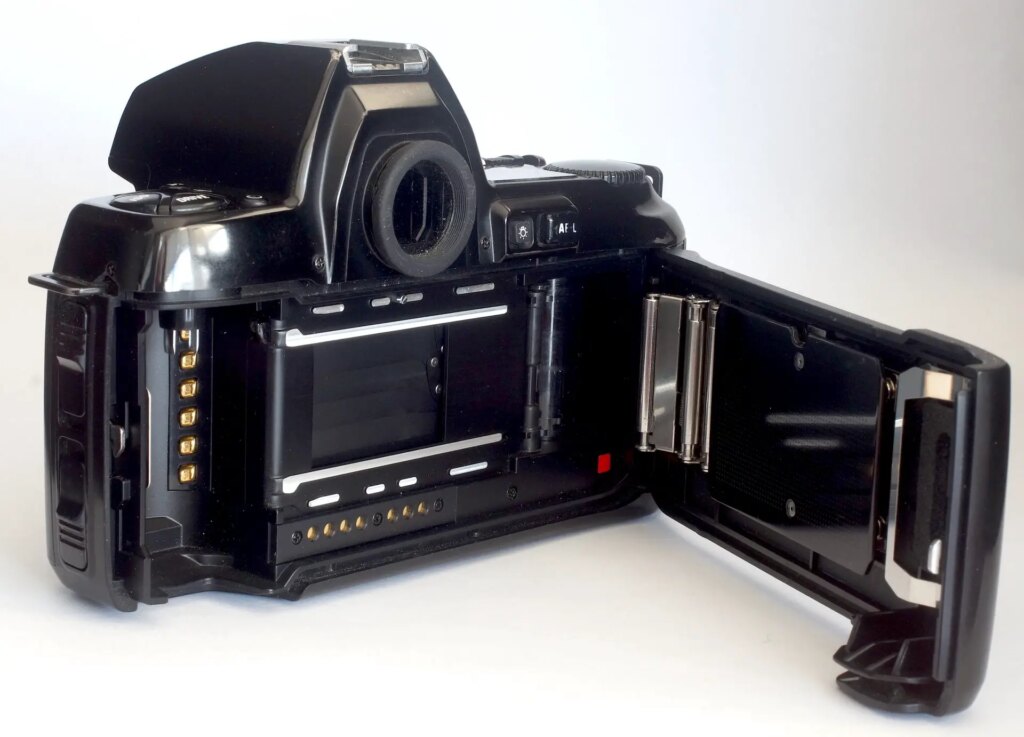
Film loading is very simple, the film being pulled across the gate and the end lined up with a red index mark. Closing the back and pressing the shutter release brings the first frame swiftly into position. Any loading mistake is signalled immediately on the LCD.
As mentioned, the Nikon F801 finder employs the same optical design as the F3HP finder so spectacle wearers or someone needing to wear goggles or eye protection could still see the whole field. The finder can have one of two alternative screens fitted and the small LCD panel across the base repeats most of the information from the top plate LCD plus a flash ready indicator.
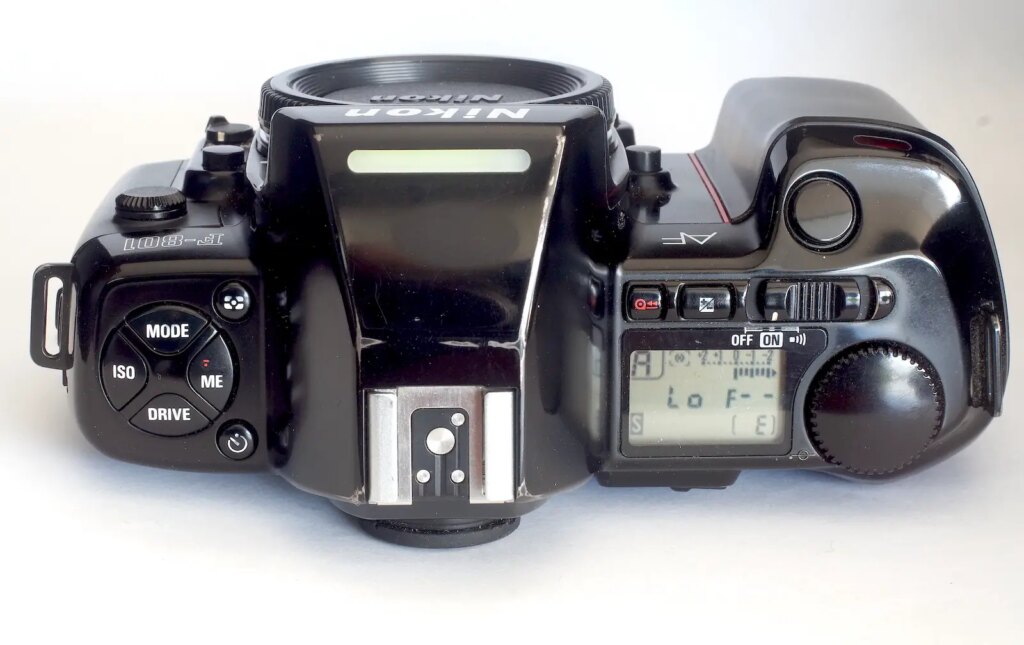
When shooting the Nikon F801, there are the options run from fully auto program to full manual control with various options in between, and with an immediate switch back to fully programmed auto by pressing the mode and drive buttons together for a few seconds. AF lenses are needed for this. All legacy Nikon lenses can be used with varying functional limitations, except for non-AI and some other lenses and accessories. The much later AF lenses with electrical connections designed for digital cameras will not work of course.
Mode, shutter speed, aperture, exposure compensation and focus confirmation are shown in the finder so adjustments can be made with the camera to the eye. The autofocus, mechanically driven rather than with a linear motor in the lens, is quick and positive but is restricted to a central patch. The focus confirmation can be used as an electronic rangefinder for non-AF lenses. Single, continuous and manual focus are options, the drive connection disconnecting in manual.
The shutter speeds go up to 1/8000sec, a high speed for a mechanical. focal plane shutter even today, and down to 30seconds. The self timer can be set between 2 and 30 seconds and a multiple exposure setting allows up to 9 exposures on one frame. Continuous shooting proceeds at a rather sedate, selectable 2 or 3.3 frames per second.
Nikon’s centre weighted metering is available along with spot and matrix metering options, the last analysing five segments of the frame and setting the exposure based on built in data of various types of scene. I have been using Nikon’s centre weighted method since my Nikkormat days but I have been trying matrix metering recently to see how effective it is. Like all exposure meters, matrix still needs watching in more contrasty situations as it seems to try to achieve the best average result and may not be what is actually envisioned. It really is a stepping stone between earlier hand-held meters, basic TTL and the very sophisticated metering we are so used to with digital today, which can assess the whole screen in much finer detail. I use all these methods with one camera or another so it is an interesting comparison.
Handling the Nikon F801 for shooting uses the left hand to press some of the function buttons and control the lens, for zooming or manual focusing, everything else is done with the right hand The AF locks with first pressure on the shutter release but there is a button on the front plate if needed for the same purpose. AE lock is controlled by a sliding button below the command wheel, convenient for right thumb operation, and exposure compensation is controlled by a button next to the on/off switch used in combination with the command dial and the LCD read-outs.
Rewinding is motorised, needing the rewind and multi exposure buttons to be pressed simultaneously which winds the film fully into the cassette.
Photos
The results below are all shot in and around Dunedin, down here in New Zealand. These examples are shot with my one remaining Nikon lens, an Ai’d Nikon 55mm/f3.5 Micro Nikkor, a Tamron 28-200 zoom and a Tamron Adaptall 17mm on Rollei Infra Red film and Ilford FP4+. I process everything in Rodinal, which is super economical and keeps forever. Most Rollei examples were shot as normal panchromatic film with some frames shot with the R72 opaque IR filter in place. Exposures can be with or without the IR filter on the same roll which is a useful option with this film. The Rollei shots are quite contrasty, especially the IR filtered ones and even without a filter blue skies retain good tone and the grain is fine but well defined. The FP4+ example has smoother, still finer grain and good contrast even when taken in rainy weather.
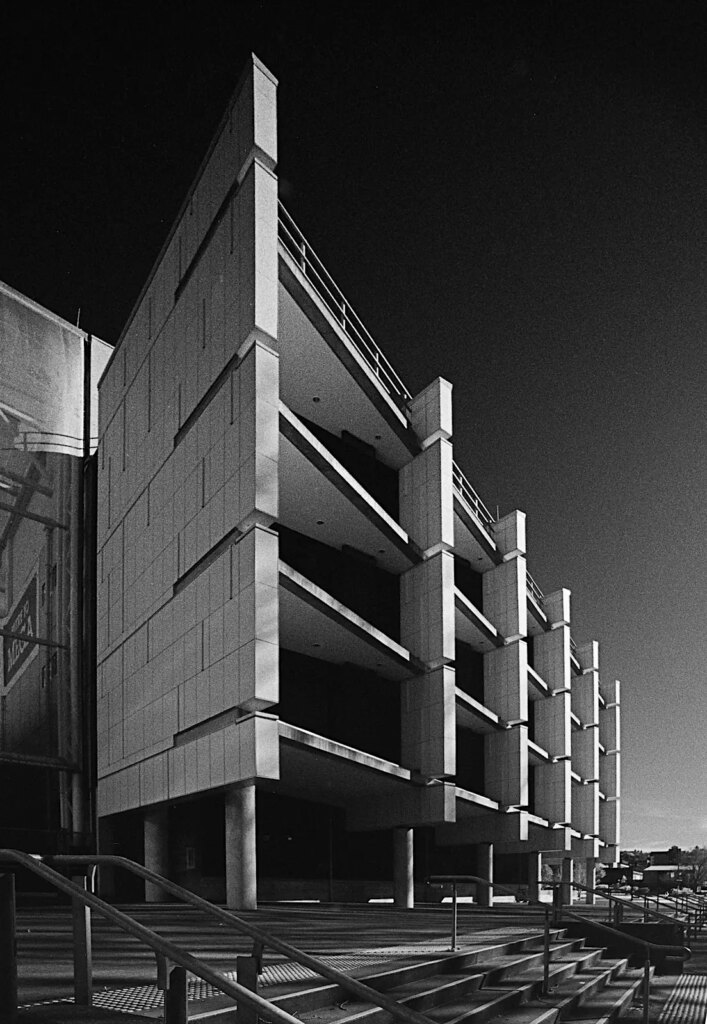
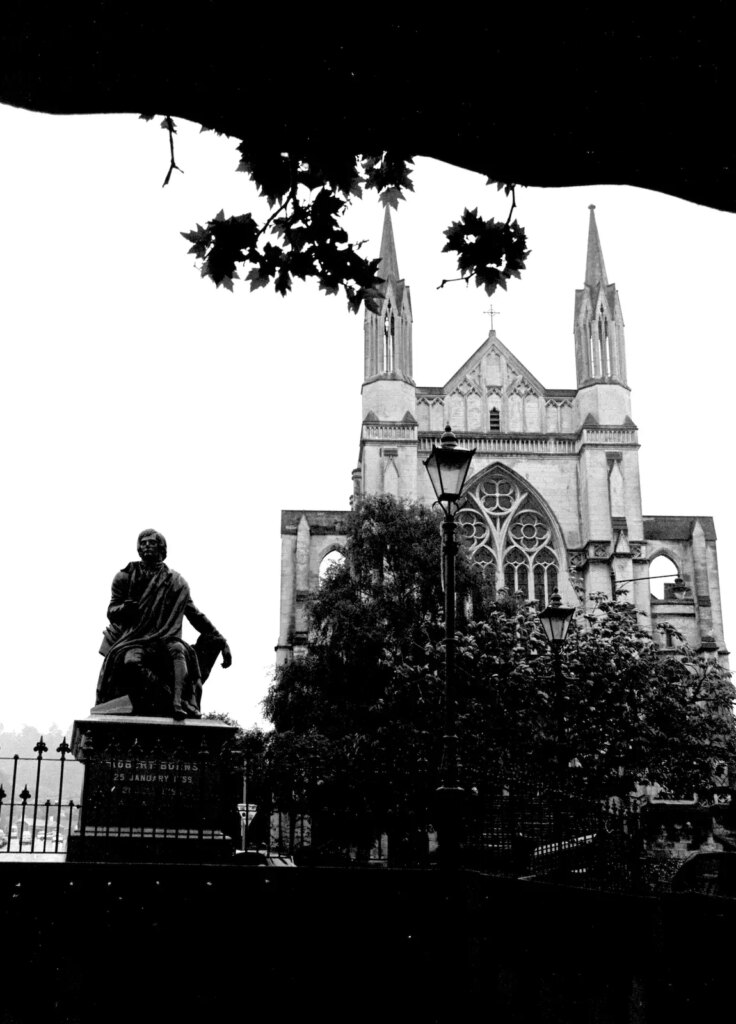
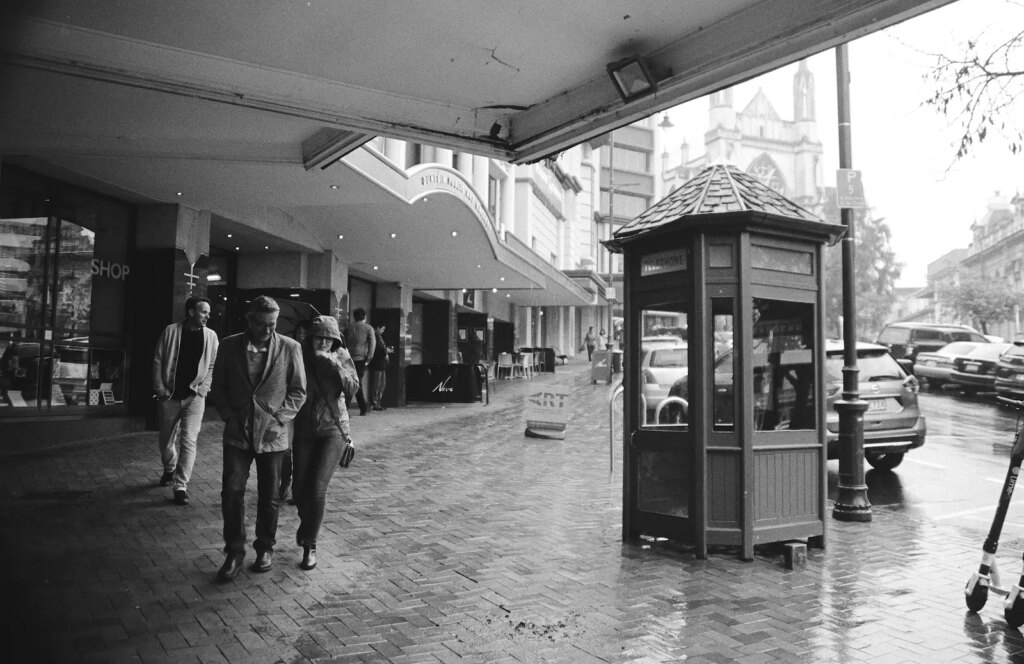
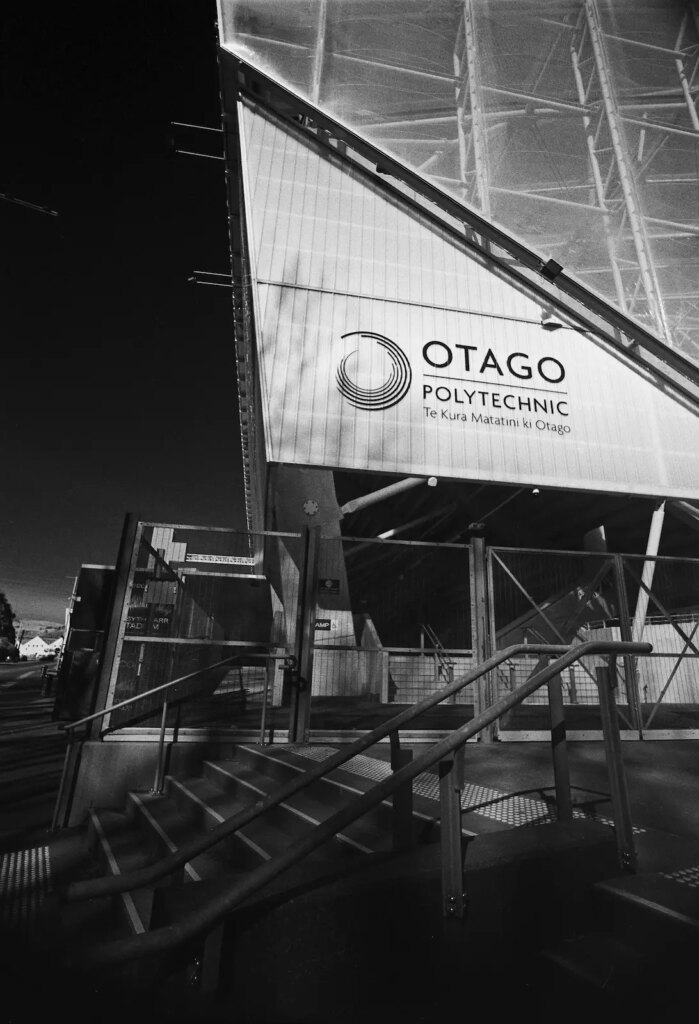
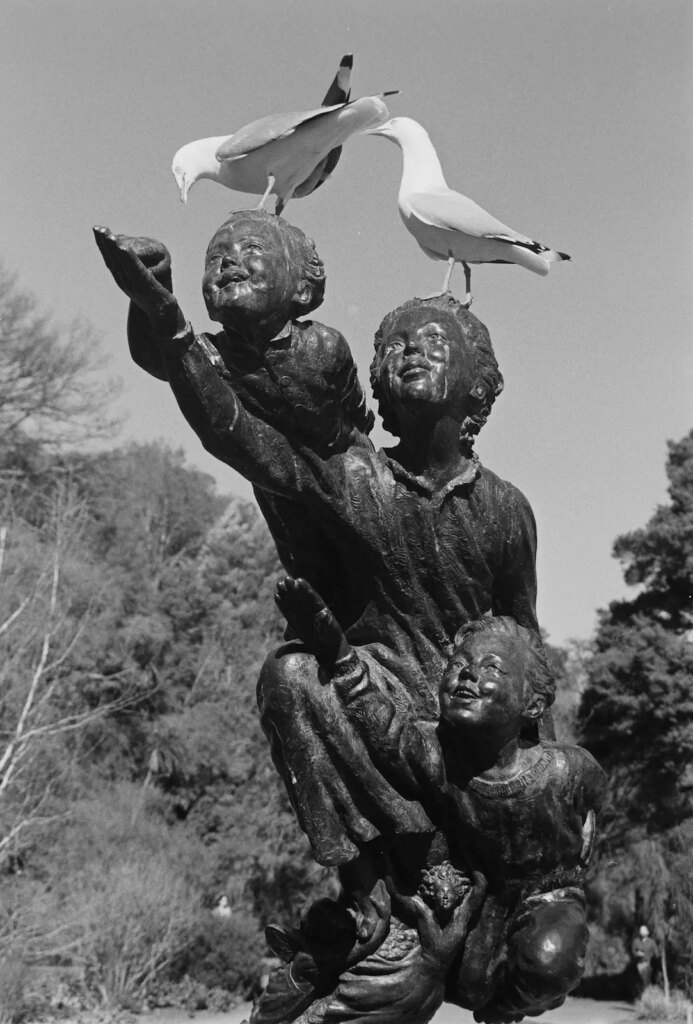
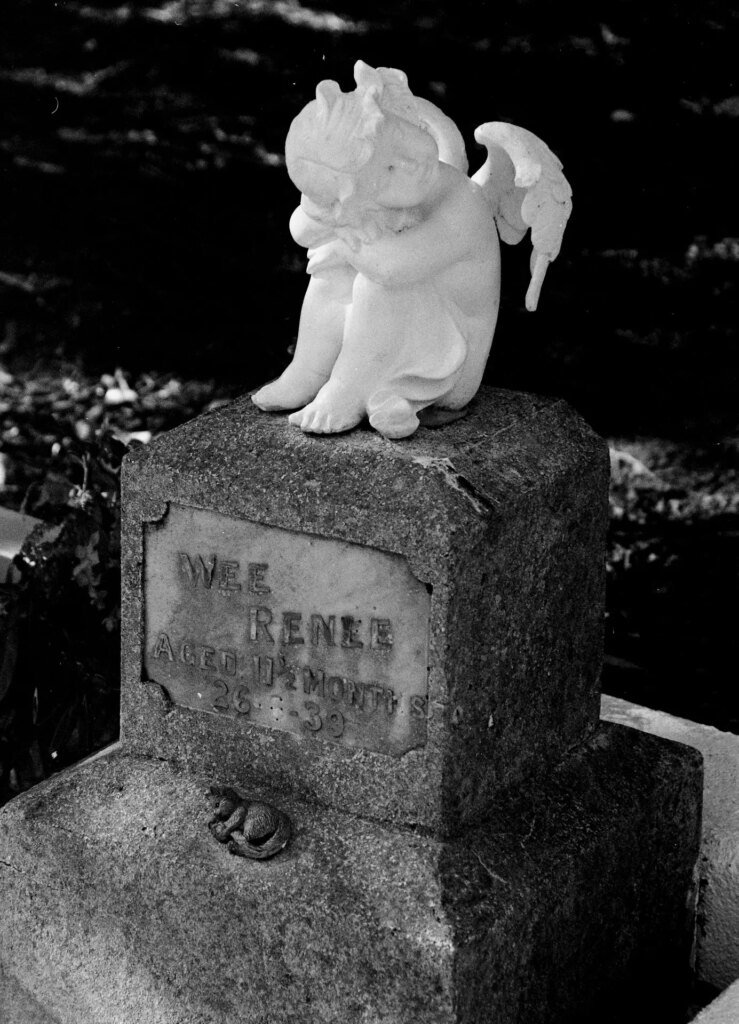
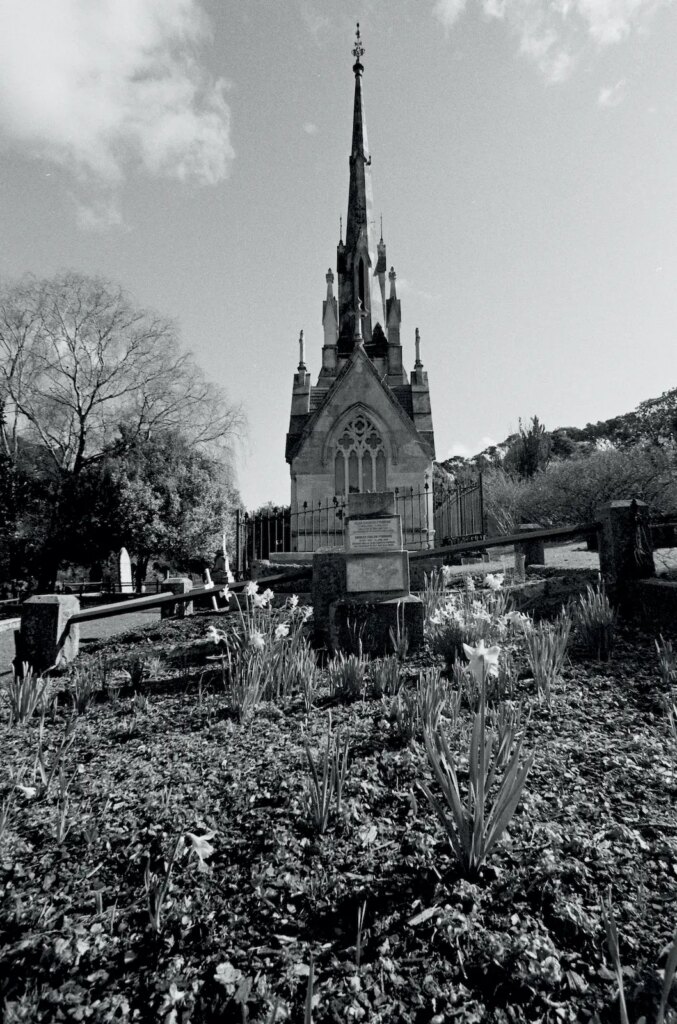
In Conclusion
I am not a Nikon fan to the exclusion of all else. I have used Nikon mainly because I started using the make with Nikkormats and progressed through other models up to the Fujifilm S2Pro digital, based on an early Nikon digital body. Not having to change systems just made sense. I have to say, however, that their products are solid and dependable, and the lenses first class.
Since returning to film, a large number of interesting cameras that I have always admired have passed through my hands when used prices dropped but I seem to have spiralled in to the viewfinder, rangefinder, TLR, SLR and mirrorless models which I use nowadays. They all demonstrate some aspect of developments in camera technology and the Nikon F801 is probably one of the last steps before the digital powerhouses available now.
(Photos of the camera and digitised copies of negatives are produced with a Sony A3000 with 55mm Ai’d Micro Nikkor and adapters processed in Affinity Photo.)
Share this post:
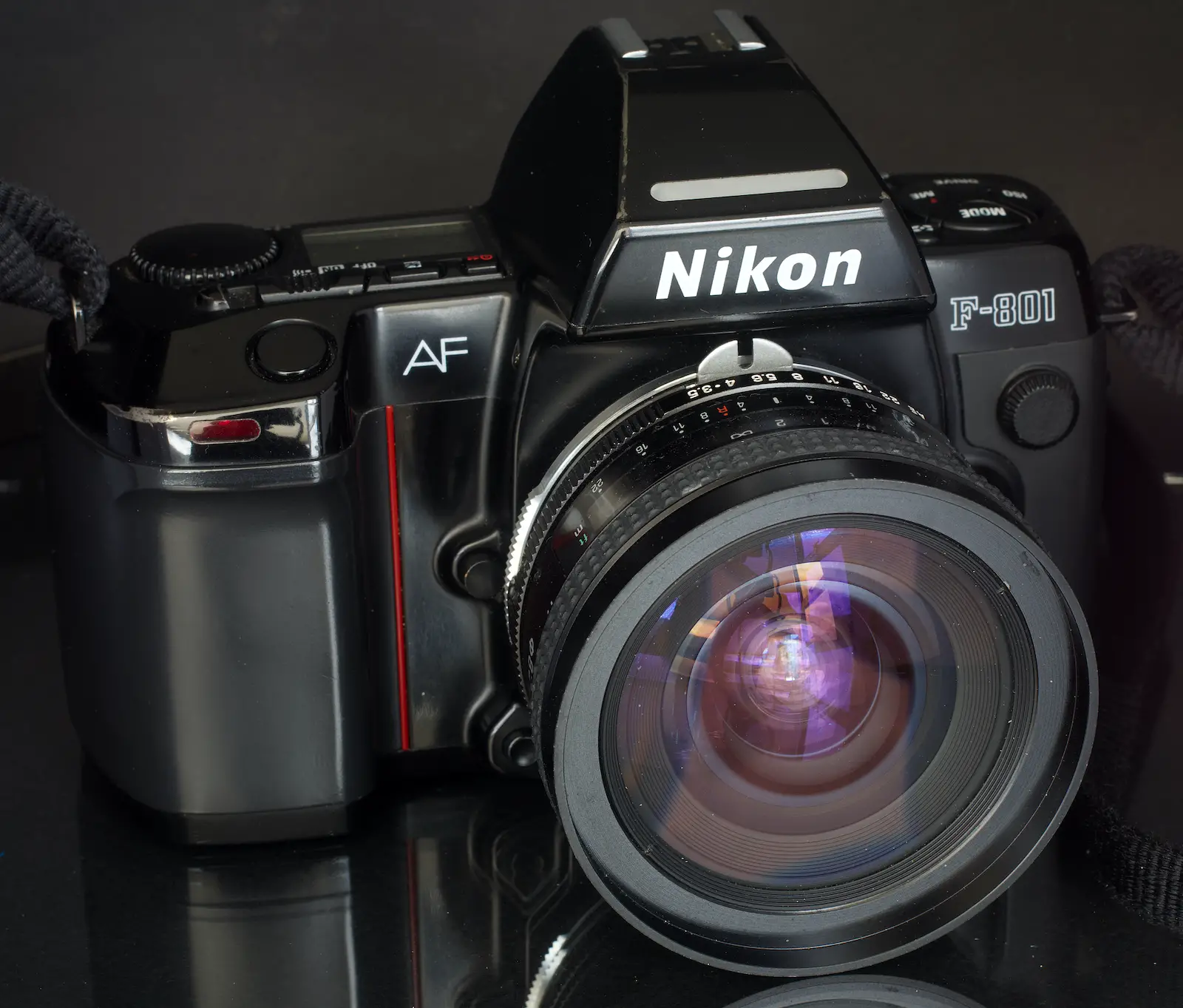








Comments
Manuel on Nikon F801 (N8008) Review – A Numbers Game – By Tony Warren
Comment posted: 27/12/2022
Comment posted: 27/12/2022
Comment posted: 27/12/2022
Hamish on Nikon F801 (N8008) Review – A Numbers Game – By Tony Warren
Comment posted: 27/12/2022
Comment posted: 27/12/2022
Dudi on Nikon F801 (N8008) Review – A Numbers Game – By Tony Warren
Comment posted: 27/12/2022
Comment posted: 27/12/2022
Comment posted: 27/12/2022
Simon Foale on Nikon F801 (N8008) Review – A Numbers Game – By Tony Warren
Comment posted: 27/12/2022
Comment posted: 27/12/2022
Castelli Daniel on Nikon F801 (N8008) Review – A Numbers Game – By Tony Warren
Comment posted: 27/12/2022
Your post brought back memories of some great times, such as photographing the birth of our daughter. I wish you continued good luck with your camera.
Comment posted: 27/12/2022
HW Kateley on Nikon F801 (N8008) Review – A Numbers Game – By Tony Warren
Comment posted: 27/12/2022
petergreyphotography on Nikon F801 (N8008) Review – A Numbers Game – By Tony Warren
Comment posted: 27/12/2022
Comment posted: 27/12/2022
Christif Bircher on Nikon F801 (N8008) Review – A Numbers Game – By Tony Warren
Comment posted: 28/12/2022
Comment posted: 28/12/2022
Tony Warren on Nikon F801 (N8008) Review – A Numbers Game – By Tony Warren
Comment posted: 28/12/2022
Tony Warren on Nikon F801 (N8008) Review – A Numbers Game – By Tony Warren
Comment posted: 29/12/2022
Would like to read about yout MF-21. It looks a very capable accessory with some very useful functions. The time lapse would be interesting for star trails.
DeShan Waring on Nikon F801 (N8008) Review – A Numbers Game – By Tony Warren
Comment posted: 23/09/2023
I still have 3 nikon 8008s cameras. Makes me want to dust them off and shoot a few rolls of film.
Comment posted: 23/09/2023
Michael Nichol on Nikon F801 (N8008) Review – A Numbers Game – By Tony Warren
Comment posted: 05/11/2023
I'm Mick from Hamilton now living in Aussie I have F801 with a 35mm - 135mm lense SB-24 flash and release cable all manuals thinking of selling to fund new camera any thoughts selling price
Thanks Mick
Comment posted: 05/11/2023
Steve Marino on Nikon F801 (N8008) Review – A Numbers Game – By Tony Warren
Comment posted: 08/01/2024
If only I could find half the camera that was smaller and lighter. The little Pentax SLR's are tiny jewels, but Pentax chose to not provide them an AE lock button. Good luck getting a shot off fast in tricky light, you have to either push buttons on top of their cameras or use the ISO setting on top. With the N8008s, you lock focus w/ your thumb on what you think is the most important part, recompose and trip the shutter. It happens really fast, and its rare to miss a shot even w/ MF lenses on the camera. Speaking of MF lenses, I prefer an 85-90 lens for a walk around, and always use Leica R 90 Elmarit and Summicrons on my N8008s cameras w/ an adapter. The image quality is a notch up from even the best Nikon lenses, and it's child's play to get 3-D photos w/ buttery smooth bokeh. The cameras will meter perfectly with any lens you can manage to get on it.Thank you for the great article on an old friend.
Comment posted: 08/01/2024